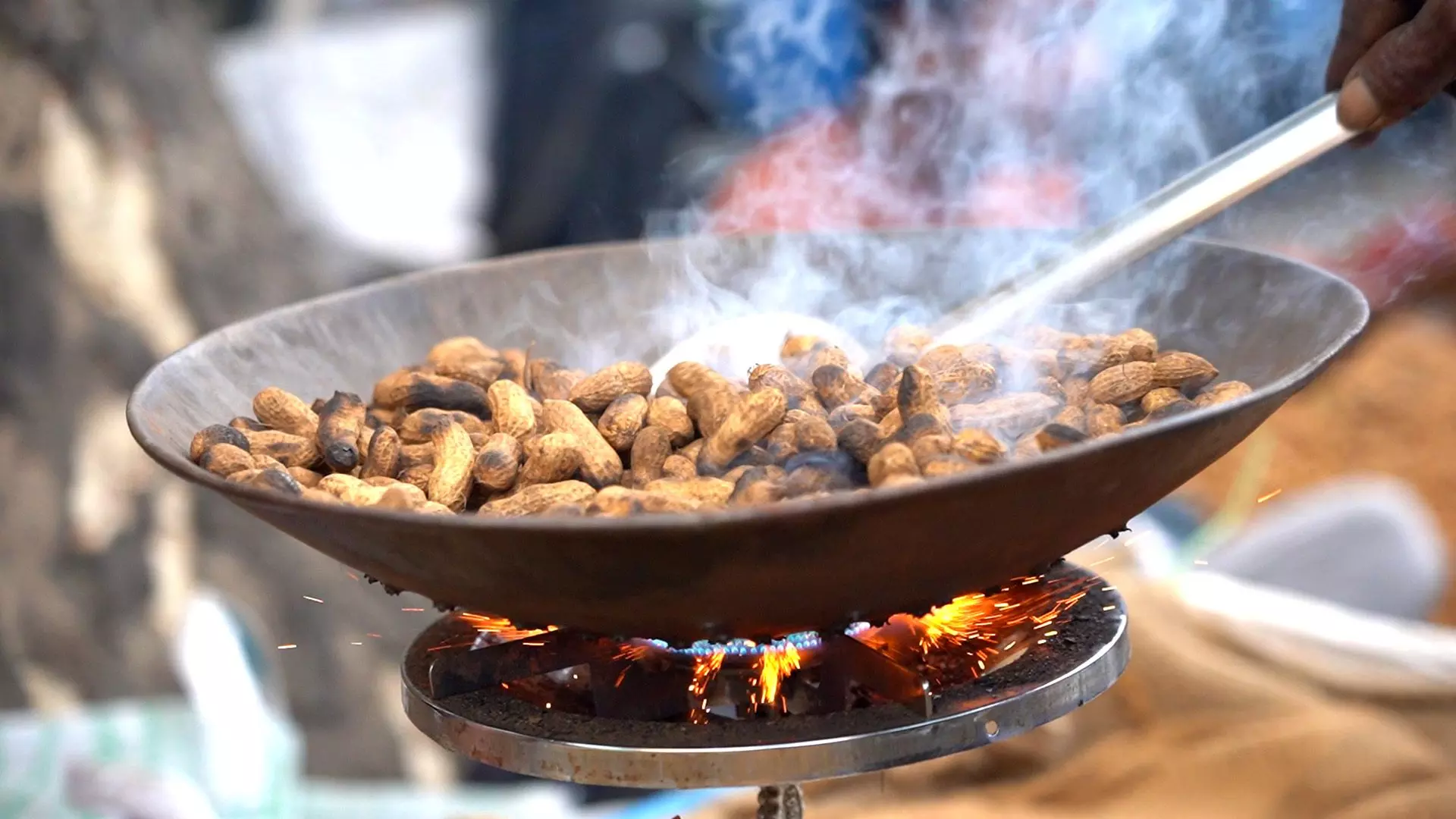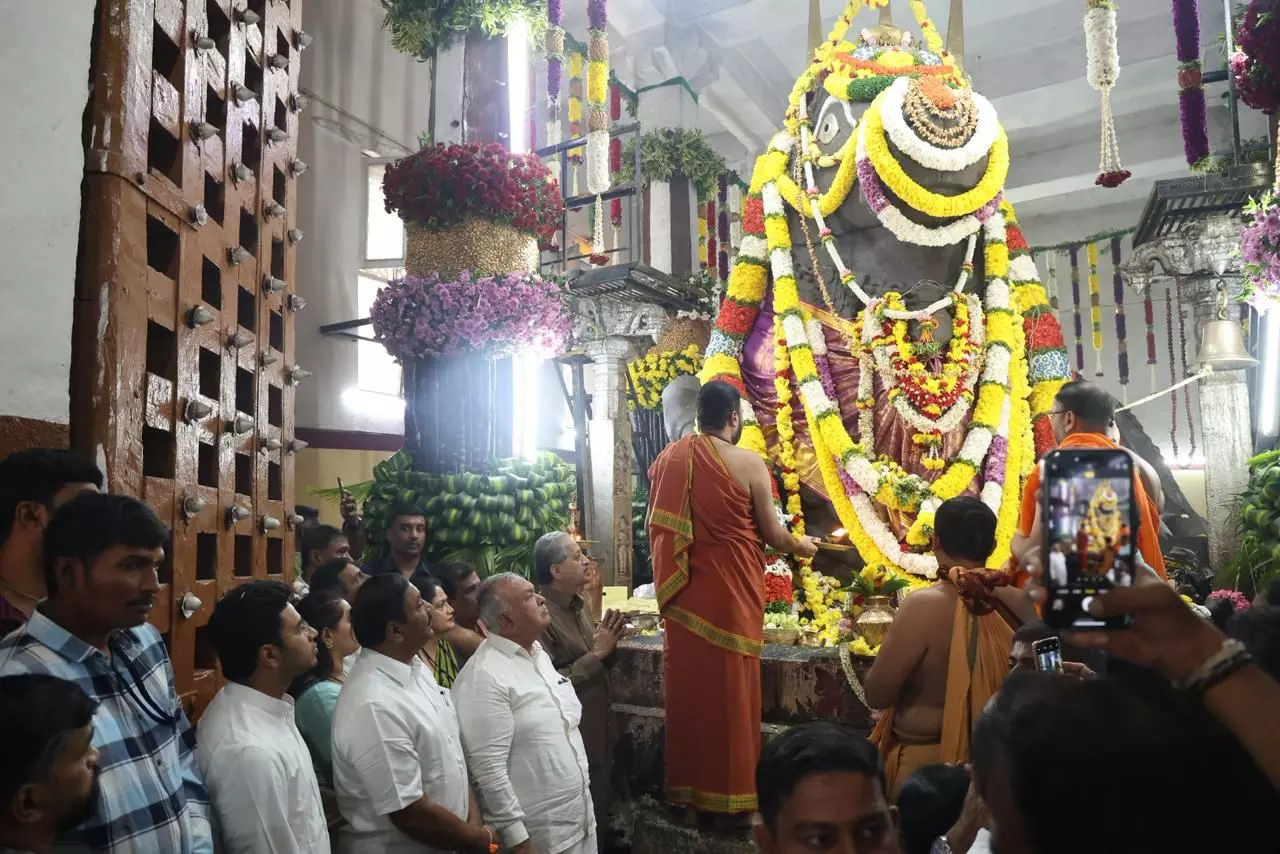
- Home
- India
- World
- Premium
- THE FEDERAL SPECIAL
- Analysis
- States
- Perspective
- Videos
- Sports
- Education
- Entertainment
- Elections
- Features
- Health
- Business
- Series
- In memoriam: Sheikh Mujibur Rahman
- Bishnoi's Men
- NEET TANGLE
- Economy Series
- Earth Day
- Kashmir’s Frozen Turbulence
- India@75
- The legend of Ramjanmabhoomi
- Liberalisation@30
- How to tame a dragon
- Celebrating biodiversity
- Farm Matters
- 50 days of solitude
- Bringing Migrants Home
- Budget 2020
- Jharkhand Votes
- The Federal Investigates
- The Federal Impact
- Vanishing Sand
- Gandhi @ 150
- Andhra Today
- Field report
- Operation Gulmarg
- Pandemic @1 Mn in India
- The Federal Year-End
- The Zero Year
- Science
- Brand studio
- Newsletter
- Elections 2024
- Events
How a groundnut festival to appease a bull became a part of Bengaluru's cultural calendar
The ongoing Kadalekayi Parishe, which started with Karnataka farmers gathering at the Basavanagudi Bull Temple with an offering of the season's groundnut harvest, today draws the IT-hub's cosmopolitan residents with its rustic charm. This year, the three-day event has seen a two-day extension.

It’s that time of the year again when Bengaluru turns back the clock to celebrate an old agrarian custom rooted in popular history and legends. The Kadalekayi Parishe, or groundnut festival, which would traditionally see farmers from across Karnataka gather at the Bull Temple in the city’s Basavanagudi to make an offering of the season’s nut harvest to the deity, has, over the past...
It’s that time of the year again when Bengaluru turns back the clock to celebrate an old agrarian custom rooted in popular history and legends. The Kadalekayi Parishe, or groundnut festival, which would traditionally see farmers from across Karnataka gather at the Bull Temple in the city’s Basavanagudi to make an offering of the season’s nut harvest to the deity, has, over the past few decades, become a part of the cultural calendar of Bengaluru.
Farmers and traders from neighbouring Tamil Nadu share space with those from Karnataka and with the IT boom in Bengaluru having drawn people from across the country to the city, visitors to the fair — which opened on Monday (November 17) this year — have become a cosmopolitan set, here to enjoy the flavour of fresh peanuts and soak in the festive mood. It’s a few days of rustic charm, amidst the city’s swanky malls and restaurants.
That Karnataka should have a celebration centred around groundnuts is not surprising; the state is among the top cultivators of the legume in the country, accounting for approximately five per cent of India’s total groundnut production in 2019-20, according to a paper titled Decomposition Analysis of Groundnut of India.
Also read: Why Bihar's Sakri residents are doubting Amit Shah’s promise of reopening state's sugar mills
Back when the Parishe started, the offering made at the temple would be followed by farmers selling groundnuts at the fair that would spring up around the Bull Temple, the Dodda Ganesha Shrine, and Bugle Rock Park in Basavanagudi — one of the oldest suburbs of Bengaluru. Today, however, the festival offers a wide range of attractions, from joyrides for children, to a range of household items, bags, bangles and even clothes, for shoppers.
Alongside, groundnuts being roasted over low flames, are hot jalebis being made and a spread of other sweet and savoury snacks — all vegetarian — to choose from. Photographers jostle with buyers and casual visitors to get the right frame, and for reel makers, the fair is a veritable paradise of colour and sounds.

Groundnuts being roasted at the fair. Photo: Raghu RD
Thirty-four-year-old Prem Singhania has been a regular visitor to the fair for the past few years. “My family is from Uttar Pradesh, but I have been living in Bengaluru for the past 15 years. I enjoy the taste of fresh groundnuts, which keeps drawing me back. It is also a great place for children to have fun,” Singhania told The Federal.
Traditionally held around the last Monday of the Karthika month of the Hindu calendar (coinciding with the months of October-November in the Gregorian calendar), this year’s fair was inaugurated on November 17 by Bharatiya Janata Party (BJP) member of parliament (MP) Tejasvi Surya and Karnataka’s minister of transport and muzrai (department of Hindu religious institutions and charitable endowments), Ramalinga Reddy, by offering nuts to the deity at the Dodda Basavanna (big bull) temple.
“More than five lakh people had participated in the historic Basavanagudi Kadalekai Parishe last year. This year, even more people are likely to visit. Therefore, necessary security personnel, deployment of marshals, installation of CCTV cameras, drinking water system, emergency medical system, toilet system and other necessary infrastructure have been provided,” Reddy told The Federal.
In anticipation of the crowd, the fair, traditionally a three-day affair, has seen an extension of two days this year and will be ongoing till Friday (November 21). Started as a farmers’ initiative, the Parishe is now organised by the muzrai department.
Also read: Why a section of Sikkim’s Dzongu residents have been waiting 10 years for a bridge to the world
Legend has it that long before Bengaluru’s evolution into a city, farmers in what is now Basavanagudi would cultivate groundnuts. However, it once so happened that a bull started coming during the night and eating up the crops. One of the farmers stayed up one night, and having caught the bull in the act, hit it with a club. According to senior columnist and Bengaluru historian, Suresh Moona, it is said that the bull simply sat down there and by morning had transformed into stone. Overcome by remorse, the farmer started praying to the Hindu deity Shiva — his steed is Nandi, the bull. “Shiva appeared in the farmer’s dream and told him to find a trident, buried in the ground in the area. The stone bull had started growing in size and in his dream, the farmer heard Shiva say that once the trident was placed on the bull’s head, the growth would stop. This was done, and a temple was built at the spot. To appease the bull, the farmers also made a vow to offer the first harvest of groundnuts to it each year,” said Moona.

The deity at the Bull Temple decked up for the festival. Photo: Raghu RD
The historian clarifies, however, that this is just a folk narrative and a much more plausible history of the fair could probably be traced back to Kempe Gowda I, the governor of the Vijayanagara empire, credited with having founded the city of Bengaluru in the 16th century. “It is said that Kempe Gowda was searching for a suitable elevated place in the city to instal the idols of Nandi, Hanuma and a goddess (Shakti), a common practice in the past to seek divine protection for the people of a place, and chose the area around the Bull Temple, to build shrines for Nandi, and the Hindu deities Ganesha and Anjaneya (Hanuman). The Bull Temple is believed to date back to his time,” Moona added.
Today, the festival sees not just the temple or the Bull Temple Road being decked up in festive garlands for the Parishe, but even surrounding areas like Gandhi Bazaar and NR Road lit up and decorated in celebration. Traders and farmers line the roads on both sides, an array of nuts heaped before them — raw, roasted, boiled, semi-boiled, take your pick.
Also read: How a nondescript Odisha village has found identity with a weekly haat for Sambalpuri sarees
“I have seen my mother coming to this fair to sell peanuts since I was a child. Now that I have taken over the business, I come here,” said 32-year-old vendor, Karthik (identified by first name only). He added: “We bring our peanuts from the RMC market in Karnataka's Belgaum [now the Belagavi district] for this fair. Business carries on till about midnight and then the next morning, we are up at 3 AM to restock. If you make an effort, business is good.”
From Rs 40-50 a seru (unit of measurement, one seru is approximately 0.93 kg) for raw and roasted peanuts to Rs 30 for a half pack, the price is uniform at most stalls, with traders having come from as far as Salem, Tiruvannamalai and Dharampuri in Tamil Nadu.

Groundnut being sold at the fair. Photo: Raghu RD
Many of the Karnataka traders, too, say they source their peanuts from the neighbouring state. Like 29-year-old Soundarya BS. A resident of Bengaluru, she says she has been selling raw, roasted and dried peanuts at the fair for the past three years, sourcing them from Dharampuri.
With the growing footfall, the muzrai department has stepped up to address concerns of littering. Working with the Greater Bengaluru Authority (GBA) it has made the parishe a plastic-free event; vendors are using paper or cloth bag to give the nuts and anyone found using plastic will be barred from putting up a stall next time. Visitors are also being made aware against littering, with offenders attracting a fine of upto Rs 2,000.
Bengaluru-born-and-raised engineer, Dilip AP, says he has seen the modest fair grown in stature in front of his very eyes. “I mostly come for the groundnuts. It is the season for fresh peanuts, and you can get authentic varieties here,” he said.
For 73-year-old Shobha G, a visit to the groundnut fair is as exciting today as it was when she was a child. “I attend with the same enthusiasm. Every year feels the same, though now, there are these new joyrides. We are here for the peanuts, what we call Basavanna's prasada,” she added.

The throng of visitors at the fair. Photo; Raghu RD
While for locals the fair is associated with memories spanning decades, even for those who have migrated to Bengaluru over the years, the parishe holds a strong attraction. “The festival has a distinctive character, it’s like a jatre [village fair], which makes it special,” said Ananda Rao Madhyastha, a senior citizen who has lived in Bengaluru for the past 35 years. He added: “It is a great crowd-puller.”
Also read: How Raghunath Sasmal made Dahibara Aludum a part of Odisha’s culinary legacy
The fair’s growing popularity and resultant changing character is, however, something that doesn’t go down well with everyone, who argue that it has diluted the core character of the parishe. “Most of those who have started coming to the fair in recent years are more interested in other snacks than groundnuts. Only those who know of the significance of the fair buy nuts,” laments Soundarya, claiming business has not been good. Her dissatisfaction is echoed by another seller, 47-year-old Jayamma (identified by first name only), who said she had been coming to the fair for the past 30 years. “For the first 19 of those years, business would be good at the fair. This year, there has been no business,” she said. Jayamma cited the barricades that had been put up by the authorities to manage public and traffic as reasons for restricting access to the fair.
Whether the spirit of the bull for whom the festival was started is happy to see the parishe expand, or feels similarly annoyed at having to share attention with the growing number of visitors, is something one can only wonder.
